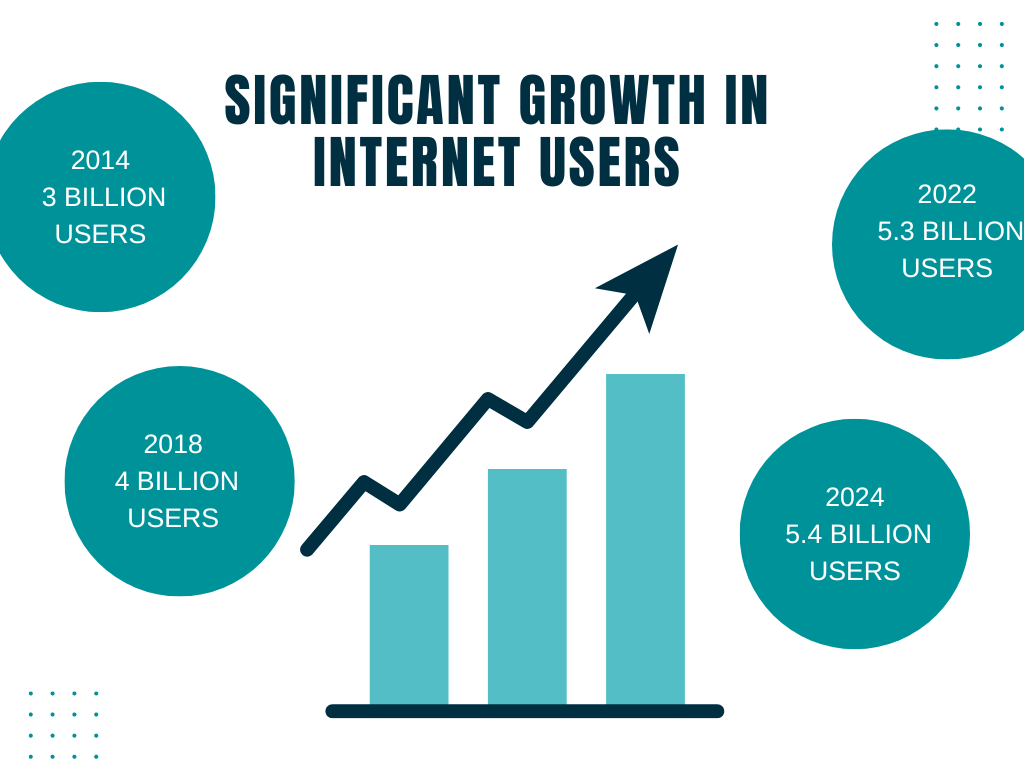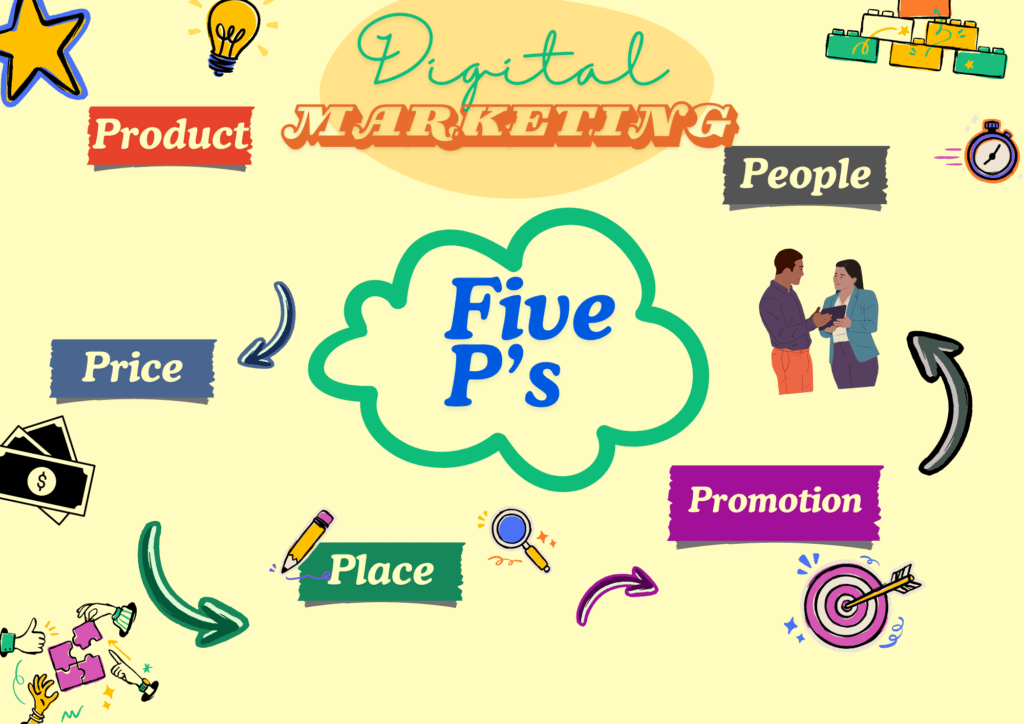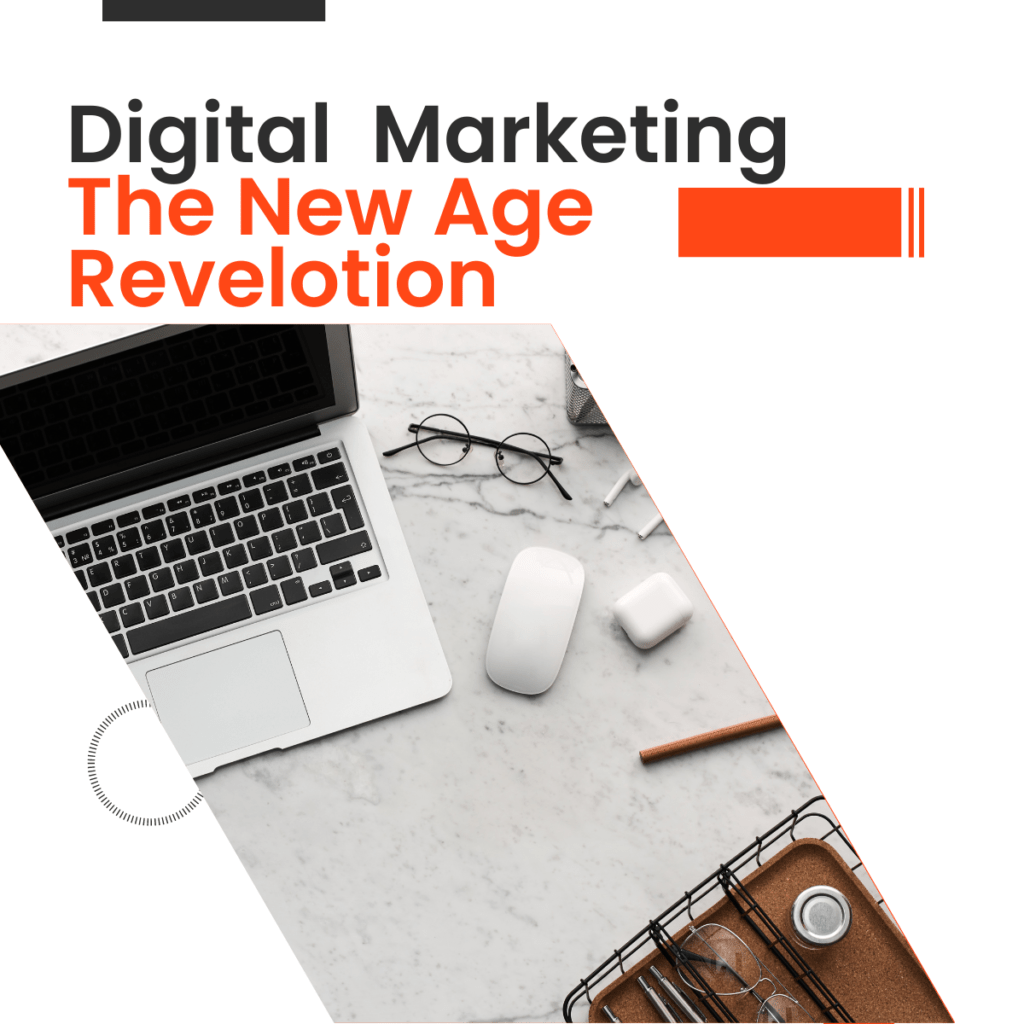You may have heard the buzzwords “digital marketing” and “hype” about seminars and other events associated with marketing.
Even though you might not want to believe it, those who exaggerate the benefits of digital marketing are frequently correct.
It can be intimidating to use digital marketing if you’ve been hesitant to do so. The following piece will assist you in blending in with the surroundings.
Companies have flooded the internet in recent years to take advantage of this, a tactic called Digital Marketing.
Digital marketing:
What is it?
All forms of marketing that depend on computers and the internet are categorized as digital.
It is the collection of tasks that an organization or person completes on the Internet. These endeavors foster connections, draw new company prospects, and forge a distinctive corporate identity.
You can infer that digital marketing is incredibly flexible and diverse from this definition.
The internet offers various tools, data, and platforms that allow marketers to personalize and distribute relevant content to target audiences.
Digital marketing techniques such as email marketing and placing ads in niche social media groups can draw in a very precise type of audience. Their message is customized to appeal to their interests.
Are you excited to promote your business to a large audience and gain a lot of interest and recognition for your brand?
Your brand should be visible to millions of people through regular and video advertisements on social media platforms and search engines.
There’s a method to contact them no matter what kind of audience you have or how specialized your goods may be.
Describe digital marketing.
Any marketing initiatives that depend on electronic devices and the internet are referred to as digital marketing.
It is the collection of tasks that an organization or person completes on the Internet. These endeavors foster connections, draw new company prospects, and forge a distinctive corporate identity.
You can see how broad and adaptable digital marketing is from this definition of digital marketing.
The internet offers a plethora of tools, data, and platforms that allow marketers to personalize and distribute relevant content to target audiences.
The Significance of Online Advertising
Although it may seem inconceivable at this point that there are still growing numbers of people using the internet worldwide, this is indeed the case. Recent studies estimate that there will be 5.4 billion internet users globally in 2024.
That is equivalent to 66% of the world’s population. Naturally, as more and more individuals get online, those numbers have only increased and will continue to do so.
These figures make digital marketing even more crucial, given how much the internet has already altered consumer behavior in terms of shopping.
To market effectively nowadays, you must reach your target audience at the appropriate times and places. More and more of your clients are using social media to research and spend time there.
The Reasons Your Business Needs Digital Marketing
With good cause, digital marketing has been heralded as a game-changer.
It provides a single platform via which companies can access a limitless supply of data, leads, and prospective clients.
One of the most profitable marketing opportunities accessible today is lost if digital marketing is neglected.
Essentially, this requirement is primarily driven by the internet.
Digital marketing offers unmatched reach and engagement opportunities that traditional approaches just cannot match, with billions of individuals accessing the internet every day.
Benefits of Digital Marketing
For every business, one of the most effective marketing strategies is digital marketing. Here are some advantages of employing digital marketing to support our claims.
- The type of marketing that is most measurable
Let’s start with what may be the most evident advantage of digital marketing: tracking.
As everyone knows, tracking a marketing strategy’s success over time is essential to making sure it succeeds. Because the internet relies so much on statistics and algorithms, it’s simple to keep track of a strategy’s actual effectiveness.
With digital marketing, it’s relatively easy to gauge a strategy’s efficacy, even though it might be a little more challenging with traditional media.
- The most economical method of promotion
Not only can you monitor every one of your posts and all the likes, comments, and shares it gets, but it’s also the most economical kind of advertising.
It’s crucial to remember that digital marketing is significantly less expensive than the majority of traditional marketing strategies.
Big businesses and smaller ones used to be separated by a paywall when it came to publicity and advertising, but that is no longer the case. Smaller businesses can now attract attention from folks that they could not have previously.
- Let’s you select any audience
Regarding audience selection, another fantastic advantage of digital marketing is that it may be as narrowly focused or as widely as desired.
On social media platforms like Reddit or Instagram, you can locate specialty forums or groups to target a very specific demographic with your marketing.
Additionally, you can reach a large audience by using internet advertisements or Facebook and Instagram sponsored posts. You may use digital marketing to locate your target audience, no matter who they are.
- Everyone has already arrived.
“Will anyone see it?” is a common issue that people have with traditional techniques of marketing.
The majority of the city’s congested areas are quite costly to rent. You don’t have to be concerned about this while using digital marketing.
The question of when someone will see it is now more important than if they will, given the billions of people who use the internet and social media every day.
There is a limit to the number of people that print advertisements and other traditional types of advertising can reach.

- Buyers commence their purchasing process via the internet
Consumers rely on the Internet for everything, even their purchasing decisions and possibilities.
An increasing in number of consumers begin their purchasing process with a study and understanding of the good or service. The internet is a great resource for additional information about everything.
Most people look for anything on the internet first since the phrase “Google it” has become so widely used in daily speech.
- You can personalize the message
One more significant benefit of digital marketing is that it lets you tailor your message to the target audience.
The world of advertising has changed since the 1950s. Back then, if you wanted to communicate with the general audience, you required a general message that could be utilized for billboards, TV commercials, pamphlets, and other forms of mass media.
Speaking with people of varied genders, ages, and hobbies made the public conversation less effective.
You may now tailor the message to certain groups based on shared characteristics, giving it a more authentic and targeted approach.
You may tailor email marketing, web advertising, and specialty marketing to target the specific population you want to attract.
How to Do Digital Marketing?
It’s not only necessary to have a strong digital marketing plan in the increasingly web-based world of today. Even if you’ve never played the game before, it’s not as hard as you may imagine to do.
Here’s a glance at the beginning process.
Establish definite goals and objectives.
A digital marketing strategy is nothing more than a wild guess that might or might not meet the target in the absence of a clearly defined goal.
Since your goals will guide all of your future efforts, set them before you embark on your path.
Remember that meaningful objectives are never ambiguous. They are quantifiable in addition to being detailed and attainable.
If not, you’ll never be able to tell if you’ve reached your objective or even just made headway in that direction.
Construct personalities for your customers.
A digital marketer used to only require sufficient knowledge and collected data on their target audience to develop a strong campaign. (Consider specifics like age, gender, place of residence, hobbies, or occupation.)
These days, though, unless you also have a set of buyer personas in your corner, your plan is incomplete.
Buyer personas are fictionalized representations of one or more of your ideal clients.
They are best generated by interviewing real members of the target group since they let marketers more easily put themselves in the customers’ shoes.
The AI Persona Builder from Rock Content can help if you’re not sure where to begin.
Perform continual keyword research.
Any successful digital marketing plan starts with extensive, continuous keyword research.
It’s the way you find out what your target audience is searching for online, so it makes sense that it’s also the secret to ranking highly on Google, Bing, and other search engines.
Additionally crucial to the optimization of your social media marketing campaign is keyword research.
Create a running list of possibilities and select a keyword research tool that interests you to get started. To increase your potential reach, use both high-performing keywords and creative long-tail substitutes.
Start and maintain a blog.
Content marketing is one of the most crucial components of digital marketing today, and a blog is one of the most powerful tools you might have at your disposal.
Adding a blog to your company’s website is an excellent approach to improving your site’s SEO and attracting interested visitors in the first place.
Set a content production schedule for your blog and keep to it so that your readers know when to anticipate fresh content from you.
Fill your blog with content that your target audience will find useful, helpful, entertaining, or simply intriguing.
Consider industry news and answers to common queries that someone looking for products like yours may have.
Increase variety using a multichannel approach.
Today’s competition is fierce therefore, you must use your ingenuity to make your marketing materials unique, engaging, and intriguing.
Innovate by taking an omnichannel strategy to digital marketing, determining where your target audience spends the most time, and meeting them where they are.
And, while written content remains the foundation of a successful content creation operation, it is far from the sole type that produces results these days.
Modern consumers prefer dynamic imagery and interesting interactive content possibilities, so incorporate infographics, movies, professional-grade photos, eye-catching designs, and so on.
Optimize for Mobile
Another important factor to consider when developing a digital marketing plan is the widespread use of mobile technologies.
Smartphones and tablets are no longer the only things consumers use to shop, consume entertainment, or look for information.
According to Dynamic Yield’s research, 76% of current consumers prefer mobile shopping because it saves them time.
Make yourself available to customers.
It’s no longer enough to just put a contact page with your email address and phone number on your website and call it quits.
Consumers today expect to have a more personal relationship with the companies with which they do business.
Your clients expect you to be more than just reachable; they expect you to be truly available, and meeting this expectation is critical.
Make sure your website’s contact page is complete and easily accessible. Your landing pages should be simple, with no demands for unnecessary data.
Differentiating yourself from the competitors.
Although the internet market offers many opportunities for great organizations to connect with the proper audience, there is also a lot of competition.
And your opponent’s share more in common with you than you realize. They sell similar products with similar selling points, and they are very definitely targeting the same demographics as you.
If you don’t stand out from the crowd, you’ll be lost in the shuffle.
So examine what distinguishes your organization. Maybe your catalog has greater diversity than your competitors’.
Perhaps your items are more dependable, efficient, or tailored to a specific type of customer than anything else available.
Monitor your outcomes.
A solid plan for collecting and evaluating data is essential to any successful digital marketing campaign, so keep a close eye on your progress at all times.
The sooner you can ascertain whether a strategy is effective, the sooner you can make the necessary adjustments to anything that isn’t functioning properly.
Honor accomplishments, but take lessons from mistakes. Additionally, as part of your process, remember to collect and take into account consumer feedback.
In the end, the best indicator of whether your marketing efforts are effective is how your target audience reacts to them.
Six Steps to Developing an Effective Digital Marketing Strategy
An organization’s eventual profitability and success are greatly influenced by its choice of digital marketing strategy. Successful strategies always take into account the values of the target client as well as the company’s ultimate objectives.
It’s one thing to know that you need a strong digital marketing plan on your side, but it’s another to put one together. The following are the crucial steps to remember:
- Conduct current market analysis
It’s crucial to avoid assuming you already know what your ideal customer wants. You might not have known months or years ago, but a lot could have happened in the meantime. Thus, it is imperative to commence each new digital marketing plan with a new round of research.
- Clearly state your objectives
As with anything else, you have to know where you’re going before you can get there. This also applies to online digital marketing.
What do you want to achieve by employing this tactic? How would achieving those targets contribute to the achievement of your overarching corporate goals?
- Know who you’re marketing to.
Not every potential customer will be a good fit for the goods and services your business offers, so it’s critical to focus your efforts effectively. This might be assisted by creating comprehensive customer profiles based on your market research.
With the use of buyer personas, marketers and content producers may more effectively envision their target audience and adjust their strategies accordingly.
- Examine your resources more closely.
You should choose how and where to market after you have a clear idea of your target audience and your goals. Begin by carefully evaluating the different resources you now have at your disposal. Examples could be: • Owned media assets, like your website, branded imagery, social media presence, and any original content you may have produced; • External digital assets, like user-generated content or guest posts on other brands’ websites; • Digital assets you purchase, like sponsored postings, pay-per-click advertising, and more;
Choose how each of these resources fits into your overall plan after that.
- Establish a timetableOne of the most crucial elements in a digital marketing strategy’s success is consistency. Excellent content and astute marketing strategies are useful, but they won’t carry you there on their own. Marketing campaigns must be delivered regularly and at the appropriate time.
Establish a timetable that you’ll stick to for creating, sharing, and advertising fresh content. Apply the same principles to important strategies like progress audits and link outreach. Then, going forward, adhere strictly to that timetable.
- Monitor your work
Every marketing plan should be built on the lessons you’ve taken away from your past tactics, in addition to continuing market research and study of customer feedback. However, you won’t have any data to go back to if you don’t record your efforts and their outcomes.
Thus, keep track of all the modifications, phases, and actions related to your strategies. Examine the outcomes. Then, apply what they tell you to further improve the efficacy of subsequent efforts.
What Are the Basics in Digital Marketing?
It’s not immediately necessary to understand how to make Google display advertisements or write website code. Here are a few key tactics to get you going:
• Building a website: Your online shop.
• Creating an Email Marketing List: Establish a connection with possible clients.
• Content Optimization for Search Engines: Boost your online presence.
• Introducing Display Ads: Make use of sites like Bing or Google.
• Using social media: Websites such as Instagram, LinkedIn, and Facebook.
• Employing Targeting Based on Location: Draw in local clients.
These fundamentals will provide a strong basis for all of your next digital marketing initiatives.
Which Digital Marketing Types Are the Main Types?
Digital marketing is a broad field with many different approaches. Below is a detailed inventory of the primary categories:
- information marketing: Producing worthwhile, pertinent information to draw in and involve your intended audience. Infographics, podcasts, videos, blogs, and more are included in this.
- SEO (Search Engine Optimization): Using technical, off-site, and on-site optimization strategies, you may increase the visibility of your website on search engines.
- Social media marketing, or SMM, is the practice of using both sponsored and organic methods on social media platforms to engage consumers and promote content.
- SEM (Search Engine Marketing): Using optimization strategies and paid ads, one can increase their presence on search engines. This covers PPC (Pay-Per-Click) advertisements as well as SEO.
- Paid Advertising: Using various forms of online advertising like Google Ads, Facebook Ads, and other social media ads to drive traffic and conversions.
- Email Marketing: Using email campaigns to communicate with prospects and customers, offering personalized content and promotions to drive engagement and sales.
- Affiliate Marketing: Partnering with businesses or individuals to promote products and earn commissions on sales generated through their referrals.
- Influencer Marketing: Leveraging influencers’ reach and credibility to promote products or services to their followers.
- Mobile Marketing: Reaching audiences on their mobile devices through SMS, app-based advertising, and mobile-optimized websites.
- Video Marketing: Using video content to engage audiences on platforms like YouTube, social media, and websites.
Recognizing Digital Marketing’s Five Ps
To make use of the special qualities and opportunities that come with digital platforms, the five Ps of digital marketing modify and build upon the classic marketing principles:
- Product: Product considerations in digital marketing encompass not only the primary offerings but also digital products, software, apps, and online services. It consists of features, updates, customer support via digital channels, and user experience (UX) design.
- Price: Pay-per-click (PPC), cost-per-action (CPA), cost-per-impression (CPI), and freemium models are examples of digital pricing models that are frequently used in digital marketing pricing strategies. Additionally, digital marketing techniques and dynamic pricing are used for price optimization.
- Place: Digital distribution channels like websites, e-commerce platforms, mobile apps, and digital marketplaces are the main focus of the location idea in digital marketing. Search engine optimization (SEO), digital storefront optimization, and online presence are all taken into account.
- Promotion: All online interactions and communication with both current and potential clients are considered a digital promotion. This includes search engine marketing (SEM), email marketing, social media marketing, influencer marketing, digital advertising (PPC, display ads), and content marketing.
- People: The term “people P” in digital marketing refers to both the target population, or customers, and the digital marketing experts who oversee and refine campaigns. Data-driven decision-making, customer journey analysis, personalization, and customer segmentation are all emphasized.

Digital Marketing versus Traditional Marketing
While reaching audiences is the goal of both, traditional marketing depends on tangible media like newspapers and TV, while digital marketing offers a wider audience and more involvement through several channels like social media, blogs, and email.
Conclusion
Now that you know the value of digital marketing and how to develop plans that work to help you achieve your objectives, it’s time to gather the tools you’ll need to get there.
It is essential to have excellent content that is visually appealing, aligns with the values of your target audience, and is search engine optimized to perfection. And to have the desired effect, you’ll need a lot of it.

